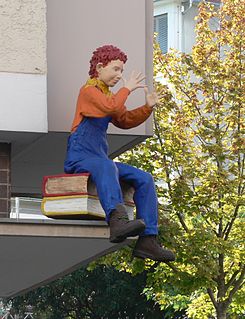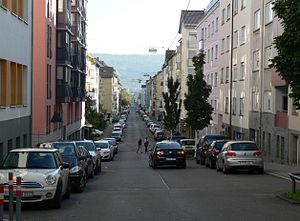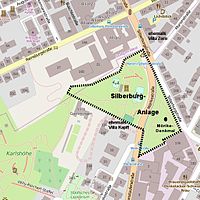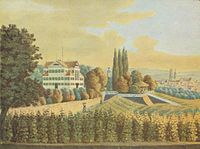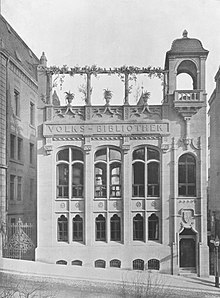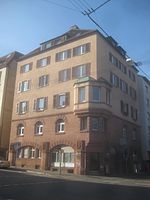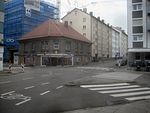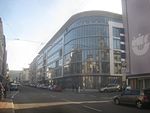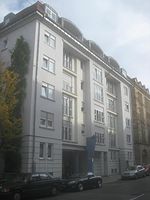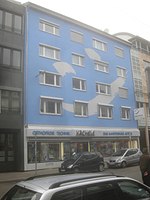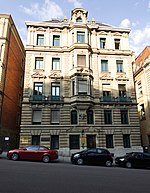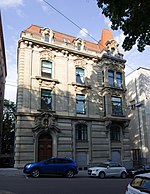Silberburgstrasse (Stuttgart)
| Silberburgstrasse | |
|---|---|
| Street in Stuttgart | |
| Silberburgstraße 42 corner figure “Naseweis” by Liane Weese-Reich |
|
| Basic data | |
| place | Stuttgart |
| Townships | Stuttgart-West Stuttgart-South |
| Created | 1851 |
| Connecting roads | Hölderlinstrasse Tübinger Strasse |
| Cross streets | Kornbergstrasse Traubenstrasse Lerchenstrasse Rosenbergstrasse Forststrasse Lindenspürstrasse Breitscheidstrasse Schloßstrasse Leuschnerstrasse Ludwigstrasse Gutenbergstrasse Herzogstrasse Rötebühlstrasse Augustenstrasse Reinsburgstrasse Mörikestrasse Marienstrasse Furtbachstrasse |
| Places | Diakonissenplatz Silberburg plant |
| Numbering system | Nos. 26-182 and 21-195 |
| Buildings | Allianz insurance Mörike monument |
| use | |
| User groups | Pedestrians, cyclists, motorists, SSB buses |
| Technical specifications | |
| Street length | around 2000 meters |
The Silberburgstraße in Stuttgart is one of a plurality of long, parallel address and shopping streets, the city areas Stuttgart-West and South Stuttgart connect in north-south direction. The street was named in 1851 after the Silberburg summer inn, which existed until 1938. Originally limited to the section between Breitscheidstraße and Marienstraße, the street expanded in the following decades to the north and south to its current length of two kilometers.
Few older buildings have survived after the destruction of World War II. The upper part of the two-lane street has little traffic, while the street in the area around Schloßstraße and Rotebühlstraße is busy and the traffic is increasing. The street is poor in trees and green spaces, apart from the silver castle complex at the end of the street.
course
Silberburgstrasse extends through the two city districts of Stuttgart-West and Stuttgart-South . It runs from Hölderlinstrasse in the north-northwest in a dead straight line and joins Tübinger Strasse and Fangelsbachstrasse in the south-southeast at a fork. It crosses the districts of Hölderlinplatz, Rosenberg and Feuersee in Stuttgart-West and the district of Karlshöhe in Stuttgart-South.
Silberburgstrasse is located in an almost chessboard-like, sugar-hat- shaped area ( outlined in red on the map), which is bordered by Schwabstrasse, Hölderlinstrasse, Hegelstrasse, Seidenstrasse and Fritz-Elsas-Strasse and to the south by Reinsburgstrasse and Marienstrasse. Hasenbergstrasse, Senefelderstrasse, Johannesstrasse and Falkertstrasse / Weimarstrasse run parallel to Silberburgstrasse, but they do not reach the length of Silberburgstrasse.
The two-kilometer-long road begins on Hölderlinstrasse at an altitude of about 280 meters above sea level and runs gently downhill to the other end, which is about 260 meters high. Only the steep slope of the so-called Silberbuckels at the end of the street between Reinsburgstraße and Tübinger Straße has a steep gradient.
The numbering begins at the confluence with Hölderlinstrasse with house numbers 26 and 21 and ends with house numbers 182 and 195 on Tübinger Strasse. On the other north-south streets, the numbering starts at the opposite end of the street.
- Views of Silberburgstrasse
description
Silberburgstraße is a mixed residential and commercial street with consistently multi-storey, but no more than six-storey buildings. Most of the houses are new builds, which usually fit into the appearance of the street to some extent. The majority of the buildings are normal width, only two handfuls of buildings with educational and social facilities form longer blocks.
The house number 42 with the figure of a nose-wise man, house number 74 with beautiful putti reliefs, the house of the Salvation Army, the Allianz building, houses 160 and 172 in the vicinity as well as some buildings on the Silberbuckel (opposite the silver castle) are worth seeing. Trees and green spaces are almost completely missing, apart from the silver castle, the deaconess square and a few individual trees.
The upper, rather low-traffic part of the street, which begins in the north on Hölderlinstraße, consists mainly of apartment buildings, some with small shops, as well as educational and social facilities, including the Dillmann-Gymnasium and the Friedrich-Eugens-Gymnasium, the competence center Silberburg with technical schools and daycare center as well as the care facilities for the elderly, Württembergisches Lutherstift, Ludwigsstift and Friederike-Fliedner-Haus.
The busy lower part of the street in the vicinity of Schloßstraße houses rental houses, shops, bakers, butchers, a hotel, restaurants, insurance companies, the Methodist Church of Hope and a building of the Salvation Army. In the area around Schloßstraße, several shops have been established that deal with used and antique goods.
traffic
Car and bicycle traffic
Silberburgstrasse is passable in both directions throughout. The beginning of the street is traffic-calmed up to Kornbergstraße (maximum speed 30 km / h) and there is little traffic until Breitscheidstraße. There is busy traffic in the vicinity of Schloßstraße and Rotebühlstraße. The road has two lanes along its entire length and is almost continuously flanked by parking lanes. At busy intersections, the street is expanded to include turning lanes. There are no cycle paths, only at the intersection with Schloßstraße there are turning lanes for cyclists, which end at the next cross street.
Transportation
Horse-drawn railways have been in operation in Stuttgart since 1868, but they did not run along Silberburgstrasse. In 1888 the so-called Rundbahn was set up, which was electrified in 1895. The train drove between Marienstraße and the “triangle” at Breitscheidstraße through Silberburgstraße. At the triangle, a passing point of the single-track line, the tram turned at right angles from Silberburgstrasse into Breitscheidstrasse. A small triangular traffic island at the confluence of Silberburgstrasse and Breitscheidstrasse still reminds of the triangle. After the introduction of line numbers in 1910, the circular railway became line 3. From 1924, line 3 ran to Schloßstraße through Silberburgstraße. In 1962 the line was discontinued.
Today the bus lines 41 and 43 run a little way through the lower Silberburgstrasse. There are also bus and tram stops in the cross and parallel streets. At the Feuersee, in the immediate vicinity of Silberburgstrasse, there is a S-Bahn stop that is served by all S-Bahn lines.
Monument protection
Some buildings on Silberburgstrasse are under monument protection (marked in the building list in column # by a d), including classical and historicist buildings, a building in the international style and a building in the architectural style of the Nazi era.
The list of cultural monuments in Stuttgart , which was publicly available in November 2014, is the same as in 2008. In some cases, the assessment of the monument worthiness of buildings in Silberburgstrasse was criticized:
- In 1986 the historian Harald Schukraft was pleased that “in addition to the residential building [Silberburgstrasse 172], the coachman's house has also been preserved. That way you can get a good overall impression of an upper-class residential building of that time. ”The building was torn down while Schukraft's book was going to print; it was apparently not a listed building.
- The same fate befell the corner double house at Silberburgstrasse 173, which was one of the “oldest and most remarkable rental houses in Stuttgart”.
- House number 160 was not a listed building in 1984. Only after “this amazing fact” was uncovered by the press did the State Monuments Office recognize the building's worth of protection.
- The corner house number 74 with its facade made of red sandstone and seven putti allegories of the professions, one of the few older buildings that have survived, did not appear to be worthy of protection to the State Monuments Office in 2008.
history
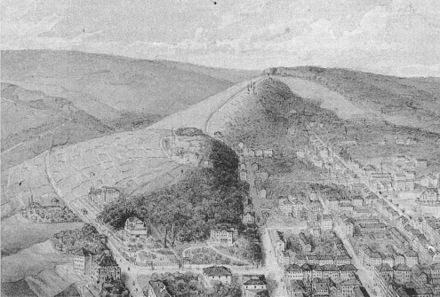
From right to left: Rotebühlstraße, Augustenstraße, Reinsburgstraße, Mörikestraße / Marienstraße, below, parallel to the edge of the picture: Silberburgstraße.
Since at least 1831 the officially nameless and unpopulated street stretched between Rotebühlstraße and Marienstraße. In 1846 it consisted of six house numbers, the counting of which began with number 1 on Rotebühlstrasse. Already in the forties the street was popularly called Silberburgstraße after the Silberburg in the immediate vicinity of the street at the confluence with Marienstraße. It was officially given this name in 1851. This year at the latest, the street was lengthened backwards to Breitscheidstrasse, and the numbering began with number 1 on Breitscheidstrasse. By 1860 the street consisted of fewer than 30 houses. In 1864 the built-up part of the street from Traubenstraße to Reinsburgstraße consisted of around 60 houses.
As a result of the backward lengthening of the street over Rotebühlstrasse to the north, which was to be extended to Kornbergstrasse in the final stage, the houses were renumbered. The numbering now began at Traubenstrasse with number 56 and ended with number 170. By 1950 at the latest, the street was extended backwards again to Hölderlinstrasse. Strangely enough, the numbering of the houses today begins with house numbers 21 and 26 and ends with house numbers 182 and 195. While the numbering on Silberburgstrasse begins at the northern end, it begins in the south of the other north-south streets in the west of Stuttgart.
The oldest buildings between Forststrasse and Reinsburgstrasse were vineyard houses from 1810 to 1840, most of which were built as plastered half-timbered houses for cost reasons. They were replaced by larger new buildings in the two decades after 1850. According to the local building statute of 1874, buildings were only allowed to be built in solid construction.
Little seems to have survived from this original condition of the road. The facades of 15 buildings date in whole or in part from before the Second World War. One can therefore assume that Silberburgstrasse was almost completely destroyed during the war. Amazingly, the huge Allianz life insurance complex at Silberburgstrasse 174A seems to have survived the war unscathed.
Silberburg
location
On the eastern slope of Karlshöhe , a "round foothills of the Hasenberg ", between the confluence of Marienstraße and Furtbachstraße, the silver castle complex (also called Mörikeanlage ) extends with the Mörikedenkmal from 1880. Mörikestraße divides the silver castle complex in a north-south direction two parts, the lower silver castle complex on Silberburgstrasse and the upper silver castle complex beyond Mörikestrasse. The silver castle was once located in the upper Silberburg complex.
history
The Silberburg was not a castle, but a country house that Lieutenant Colonel Freiherr von Irmtraut had built around 1798. Prince Friedrich von Thurn und Taxis bought it from him in 1803. The master cooper and innkeeper Lorenz Silber, who had been running a café in the Kleiner Bazaar building at Königstraße 45 since 1804, bought the property after the prince's death in 1806 and converted it into a summer inn. After the name of the owner and the castle-like view of the country house, the house was named Silberburg. Silber had the old country house demolished in 1816 and relaunched with a hall extension. The building remained in this condition until 1938.
In 1836 the museum society took over the property "for the maintenance of upscale entertainment and for further training in literary and artistic fields", which was therefore usually no longer open to the larger public. After 99 years, the site was sold to the Reichsrundfunksender in 1936 . The Silberburg was demolished in order to erect a monumental broadcasting building instead, which was then to be built on the top of the Karlshöhe, a plan that was not implemented because of the Second World War. After the war, the area came into the possession of the city in 1950 by way of an exchange of land with the Süddeutscher Rundfunk .
The Silberburg was a popular excursion destination, which was also shown to prominent visitors (see celebrities ). For years, the Schiller Festival of the Stuttgarter Liederkranz took place at the Silberburg , in 1834 it was the venue for the annual conference of the Society of German Natural Scientists and Doctors . In 1842 the Royal Württemberg Railway Company was founded on the Silberburg , and in 1861 the Stuttgart Beautification Association . In 2011, a memorial stone was placed on the site of the former Silberburg to commemorate the founding of the Beautification Association.
People's library
The Volksbibliothek Stuttgart association was founded in 1897. The library was temporarily housed in the courtyard of the legion barracks at the current location of the Wilhelmsbau at Königstraße 84.
The publisher Carl Engelhorn , who was involved in founding the public library association, had built a house in 1894 at 189 Silberburgstrasse, which he used as a residential and publishing house. In 1899 he acquired the neighboring property on Silberburgstrasse 191. He made the property and a generous donation available to the association with the stipulation that a building for the public library would be built on it. The Eisenlohr & Weigle office provided the plans for the building . A roof garden on the building, which was connected to the Engelhorn house by a bridge, was intended to "replace the sorely missed nature" for his heart-sick wife, who could no longer leave the house.
In 1901 the new building was given its purpose as a public library. In 1936 the Nazis dissolved the association. In 1938, the headquarters of the “Stuttgart People's Libraries” was moved to the building of the former People's Library and renamed the Mörikebücherei. During the Second World War, the house was destroyed and a large part of the book collection was destroyed. After the war the library was housed in the Wilhelmspalais . The destroyed building was replaced by a new building, into which the city archive moved. In 2011 the city archive moved to a large building complex outside the city center in Bad Cannstatt.
Celebrities
Visitors passing through were gladly taken to the Silberburg by their hosts, including the famous poet Jean Paul and Wilhelm Müller , the author of " Wandering is the miller's pleasure ". The poet Bruno Frank and the theologian Theophil Wurm lived at times on Silberburgstrasse, and Eduard Mörike is often connected to the street.
Silberburg
The poet Jean Paul , who stayed in Stuttgart for around a month in 1819, was also invited to a trip to the Silberburg, which he described in a letter to his wife as “the most beautiful place [Stuttgart]”, not without adding: “ But everything beautiful is far from Stuttgart. "
In 1827 Gustav Schwab invited his visitor Wilhelm Müller (“ Wandering is the miller's pleasure ”), who had been in Stuttgart for ten days, for a walk to the Silberburg. Like Jean Paul, he didn’t leave Stuttgart good: "We went together to the so-called Silberburg, an inn on the hill, from where you can overlook the whole city, which, however, does not give a significant picture."
Eduard Mörike
Eduard Mörike , born in 1804 in nearby Ludwigsburg , was almost a native of Stuttgart because, with short interruptions, he spent the last third of his life in the city of Stuttgart. Peter Härtling called Mörike a “neurotic escape in a confined space”. In 17 years Mörike had made a dozen different places of residence in the greater Stuttgart area, and in Stuttgart he changed ten times in a quarter of a century. Four of these apartments were in cross streets along Silberburgstrasse: Reinsburgstrasse 67, Augustenstrasse 14b, Rotebühlstrasse 65 and Breitscheidstrasse 51. When he lived on Breitscheidstrasse, he rented a garden on Kornberg (where Kornbergstrasse is now).
At the suggestion of Friedrich Theodor Vischer , who lived in Stuttgart and had been friends with Mörike since his youth, the Mörike memorial was unveiled in the Silberburg complex five years after Mörike's death in 1880 . "Since it is the center of [even so] named after him" Mörike-conditioning "and in 1884 its name to the voltage applied to the 1870erJahren Mörikestraße." 1901 was the opposite the Mörike Memorial Public Library opened, which was renamed Mörike library 1938th
Bruno Frank
The only prominent writer who lived on Silberburgstrasse for a long time was Bruno Frank , who is commemorated by a plaque on the house where he was born, number 159. His father, an assimilated Jew , was very wealthy (in 1914 he had a fortune of two million marks). Bruno Frank attended the humanistic Karlsgymnasium on Tübinger Strasse. In 1902, however, he had to leave school because of "insubordination". Thereupon his parents sent him to Thuringia to the Haubinda Landerziehungsheim , a boarding school oriented towards reform education . Two years later he returned to Stuttgart, where he passed the Abitur one year later in 1905 at the Eberhard-Ludwigs-Gymnasium .
A formative childhood memory from Silberburgstrasse found its way into Frank's most successful play, the 1930 comedy Sturm im Wasserglas . The Silberbuckel, the steep end of the street, was in the immediate vicinity of Frank's house. In the comedy, the journalist Burdach reports from his childhood: “The trucks went up every day with heavy stone loads. Many were too heavy for the horses. But the horses had to go up. They lay down in the harness so that the straps cracked. Often it still didn't work. Then the carters struck. On the horses 'backs, in the horses' faces. With the handle of the whip on the nostrils, with the fist in the eyes, with the heel of the boot into the points. It just had to go. It always worked. I've seen that from the window of our apartment for fifteen years. "
As early as 1925, Frank reported in an article for a magazine about this “primordial experience” that justified his pity for the creature ”:“ The horror felt at the time, the hatred received at that time have remained my basic experience. I like to live and I live happily. But on every path in the world I encounter the pack horses from Silberburgstrasse, in a hundredfold transformed shape, tormented by roaring servants. "
In 1905 Bruno Frank left his hometown. He studied at various universities in Germany and did his doctorate in Tübingen. In the First World War he served as a soldier. After the war and until the end of his life he worked as a freelance writer. In 1933 he emigrated first to Austria, then to other European countries and finally to California, where he made friends with other German writers in exile, including Thomas Mann , Lion Feuchtwanger and Ludwig Marcuse .
Bruno Frank is one of the almost forgotten authors, and he has enriched German literature with some important works, including the novels Trenck and Cervantes . After all, the city of Stuttgart dedicated a plaque to him in 1987. After the Second World War, around 200 streets in Stuttgart were renamed, including many with politically motivated names from the Nazi era. In Heumaden , the former Bergerstraße was given the name Bruno-Frank-Straße without any local reference to Bruno Frank being recognizable.
Theophil Wurm
The theologian Theophil Wurm was regional bishop of the Evangelical Church in Württemberg from 1929 to 1948 . His official residence was the neo-baroque building Silberburgstrasse 187. After an initial compromise course, he immediately opposed official policy in the Third Reich. One of imposed against him under house arrest and his dismissal led to public opposition statements. In October 1934, around 7,000 people protested against the arbitrariness of the Nazi authorities in front of his official residence. A bronze commemorative plaque on the house has been a reminder of these events since 2004. The district court lifted the punitive measures and Wurm remained bishop. In 1940 Wurm became the first German bishop to oppose the euthanasia laws , and in 1943 he publicly protested against the persecution of the Jews . From 1945 to 1949 Wurm was the first council chairman of the newly founded Evangelical Church in Germany (EKD) .
Building list
The following building list contains the buildings and squares on Silberburgstrasse that are characterized by their age, architecture or special features.
| → Column legend and sorting | ||||
| Legend | ||||
|
||||
| Sorting | ||||
| image | year | No. | # | Object / literature | |
|---|---|---|---|---|---|
| 42 | House with the Naseweis bookstore on the corner of Kornbergstrasse. Corner figure of a pointer on a stack of books by the theater sculptor Liane Weese-Reich (see also cover picture). | ||||
| 57 | Friederike Fliedner House. Consoles with wooden envious heads (shock masks). Photo right: Neidkopf. |

|
|||
| 59 * | Diakonissenplatz in the Carré Silberburgstraße, Forststraße, Falkertstraße and Rosenbergstraße. There is a youth traffic school on the square, which is to be replaced by a play area and open space. Literature: #Schukraft 1986 , page 162. |
||||
| 74 | Residential and commercial building on the corner of Rosenbergstrasse, facade on the ground floor and 1st floor made of red sandstone, corner bay window on the 1st and 2nd floor. On the ground floor, seven putti reliefs with genre scenes as the end of the blind pillars between the windows. Photo right: six putti reliefs. |
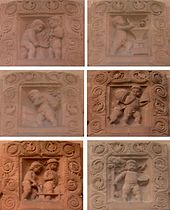
|
|||
| 1952-1954 | 86 | d | Friedrich-Eugens-Gymnasium, international style from 1950 . Worthy of monument as a “good example of school building architecture”. Literature: #Schukraft 1986 , page 162, #Stuttgart 2008 . Architect: Hans Brüllmann, client: City of Stuttgart. |
||
| 1956-1958 | 87 * | d | Dillmann-Gymnasium, international style from 1950 , side front on the corner of Forststraße 43. Awarded the Paul Bonatz Prize “as the best example of school architecture in Stuttgart in the 1950s”. Mosaic wall by Christian Oehler (1909–1986), coloring by Sachse & Rothmann. Literature: #Schukraft 1986 , page 162. Architect: Peter Salzbrenner, Karl H. Neumann, client: City of Stuttgart. |
||
| 100 * | The intersection of Silberburgstrasse and Breitscheidstrasse, where the former Dreieck tram stop was located. Photo left: Eckhaus Silberburgstraße 100, right triangle, photo right: around 1900. more ... |

|
|||
| 114 | House facade of the Hansa Hotel with the facade painting of a Hansa cog . | ||||
| 2002 | 122 | Headquarters of the Medical Service of Health Insurance. The house at Silberburgstrasse 122 and the buildings at Leuschnerstrasse 43-45 form the L-shaped Silberburg-Carré. New building in place of the Carl A. Pfeiffer piano factory (from 1864), today in Leonberg , or since the 1950s by C. & E. Fein , today in Schwäbisch Gmünd , which produced power tools here until 2002 (?), Among other things the first electric hand drill . Literature: #Skrentny 2011 , pages 271, 294. Architect: Stefan Willwersch. |
|||
| 1860 | 135-137 | n | Double tenement house, replaced by a new building after 1986. Photo on the right: fountain column. Literature: #Schukraft , page 159. |

|
|
| 139 | d | House of the Salvation Army , neoclassicism . Literature: #Stuttgart 2008 . Architects: Stahl and Bossert. |
|||
| 1859 | 141 | Former house of the wine grower Wilhelm Lutz. On the facade on the ground floor there is a cast-iron plaque with the gilded relief of a wine grower ( Saint Urban ) with a child. Photo right: plaque. Literature: #Schukraft 1986 , page 159, #Wais 1954.1 , page 48. |

|
||
| 150 | House facade with the logo of Orthopädie-Technik Kächele. | ||||
| 1920 ~ | 157 | Sanwald brewery inn . Literature: #Skrentny 2011 , page 294. |
|||
| 159 | d | Birthplace of Bruno Frank with a memorial plaque. more ... Photo right: memorial plaque. Literature: #Kirchner 2009 , #Walter 1992 , pages 43-44. |

|
||
| 1853 | 160 | d | Former Villa Harpprecht, neo-renaissance , classicism , several renovations and extensions (1875, 1905, 1925). From 1875 to 1966 owned by the Vincentians . They set up a nursing ward in the house, which is considered the predecessor of the Marienhospital . On the second floor two facade sculptures by an unknown sculptor, left: Louise de Marillac , right: Vincent von Paul . –Before the renumbering of the houses in Silberburgstrasse, the house was number 60. Literature: #Beitl 1990 , #Schukraft 1986 , page 160, #Stuttgart 2008 , # newspaper cuttings , August 28, 1986. Architect: Joseph von Egle , client: Heinrich by Harpprecht . |
||
| 1867 | 172 | d | Former Schnabel house on the corner of Reinsburgstrasse, historicism (Italian) neo-renaissance , originally the house of the banker Schnabel, business of Adolf Krabbe's bookstore towards the end of the 19th century. Literature: #Schukraft 1986 , page 160, #Stuttgart 2008 . Architect: Carl Walter , client: Banker Schnabel. |
||
| 1857 | 173 | - | Former tenement house on the corner of Reinsburgstrasse 17, half-timbered building, demolished after 1986, house number no longer available. Literature: #Schukraft 1986 , page 160. |
||
| 1899-1900 | 174A | d | Allianz life insurance. Literature: #Schmidt 2006 , page 379–382, #Stuttgart 2008 . Architects: Eisenlohr & Weigle , client: Life insurance and savings bank Stuttgart. |
||
| 174 * | Silver castle complex with Mörike monument . Between the building Silberburgstraße 174A (Allianz) and Silberburgstraße 178. more ... |
||||
| 1899-1900 | 177 | - | Friedrich Kolb's house with caryatids by Viktor Cappeller from 1873. Photo right: 1876. Literature: #NN 1876.2 . Architect: Johann Wendelin Braunwald , client: Friedrich Kolb. |

|
|
| 1881 | 185 | d | Tenement house. Literature: #Stuttgart 2008 . Architect: Albert Eugen. |
||
| 1890-1891 | 187 | dg |

Apartment building, historicism ( neo-baroque ). Memorial plaque for Theophil Wurm , regional bishop of the Evangelical Church in Württemberg , who lived here from 1929–1943. |
||
| 1891-1894 | 189 | d | Engelhorn publishing house and residential building. Photo right: 1895. more ... . Literature: #Schmidt 2006 , pages 285–288, #Stuttgart 2008 . Architects: Eisenlohr & Weigle , Lambert & Stahl , client: Carl Engelhorn . |

|
|
| 1899-1901 | 191 | d | House of the former public library, since 1938 Mörikebücherei, after the war until 2011 the seat of the Stuttgart City Archives. more ... . Photo right: 1902. Literature: #Schmidt 2006 , pages 372–375, #Stuttgart 2008 . Architects: Eisenlohr & Weigle , client: Verein Stuttgarter Volksbibliothek. |
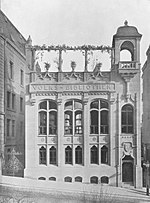
|
|
literature
General
- Memorial plaques. In: Official Gazette of the City of Stuttgart of December 10, 1987 (Louis Hallberger, Wilhelm Waiblinger, Gerhard Storz, Georges Cuvier, Bruno Frank, Friedrich Hölderlin, Friedrich Theodor Fischer).
- Architektonische Rundschau Volume 18, 1902, Issue 12, Plate 89 (Silberburgstrasse 191).
- Max Bach ; Carl Lotter (ed.): Pictures from Old Stuttgart , Stuttgart 1896.
- Gottfried Bauer; Ulrich Theurer; Claude Jeanmaire: Stuttgart trams. A documentation about the tram lines from 1868–1975 , Villigen (Switzerland) 1976.
- Margarita Beitl; Eberhard Gönner (ed.): Marienhospital 1890–1990 , Untermarchtal 1990, pp. 26–29, 35, 40 (Silberburgstrasse 160).
- Irene Ferchl : Stuttgart. Literary milestones in the book city , Stuttgart 2000.
- Bruno Frank: Pack horses . In "Owl", Volume 2, Issue 12, September 1925, p 37, online: .
- Bruno Frank: Storm in a glass of water. Comedy in three acts , Munich 1930.
- Sascha Kirchner: The citizen as an artist. Bruno Frank (1887-1945). Life and work , Dusseldorf 2009, excerpt online: .
- Golo Mann : On the twentieth anniversary of Bruno Frank's death . In: "Neue Rundschau", volume 76, issue 3, 1965, pp. 533-535.
- Antero Markelin ; Rainer Müller: Stadtbaugeschichte Stuttgart , Stuttgart 1991.
- Bernd Möbs: On foot to Stuttgart's poets. Literary walks , Tübingen 2008, pages 130–132.
- NN: New buildings in Stuttgart and the surrounding area , volume 2: House of Mr. Friedrich Kolb, JW Braunwald, architect , Stuttgart [1876] (Silberburgstraße 177).
- Karl Pfaff : History of the city of Stuttgart based on archival documents and other proven sources , Volume 2: History of the city from 1651 to 1845 , Stuttgart 1846.
- Annette Schmidt: "Denkmalwuth!" The Mörike monument in Stuttgart . In: "Preservation of monuments in Baden-Württemberg", Volume 30, 2001, p. 50.
- Annette Schmidt: Ludwig Eisenlohr. An architectural path from historicism to modernity. Stuttgart architecture around 1900 , Stuttgart-Hohenheim 2006 (Silberburgstrasse 174A, 189, 191).
- Harald Schukraft: Stuttgart Street History (s) , Stuttgart 1986.
- Hans-Ulrich Simon: Mörike houses. Living in Stuttgart between 1851 and 1875 , Stuttgart 1996.
- State capital Stuttgart, Office for Urban Planning and Urban Renewal, Lower Monument Protection Authority (publisher): List of cultural monuments. Immovable architectural and artistic monuments , Stuttgart 2008, online: .
- Gustav Wais : Stuttgart's art and cultural monuments. 25 pictures with explanations of city history, building history and art history , Stuttgart [1954].
- Eva Walter; Thomas Pfründel: The Stuttgart street names in Stuttgart , Stuttgart 1992, pp. 43–44, 222–223.
- Georg Wochner: Stuttgart for five and twenty years. Attempts to draw views from the capital in a series of pictures , Stuttgart 1871.
Silberburg
- Carl Lotter: History of the Museum Society in Stuttgart. To celebrate the 100th anniversary of the company , Stuttgart 1907.
- Paul Sauer : The Becoming of a Big City, Stuttgart between the founding of the Empire and the First World War 1871–1914 , Stuttgart 1988
- Gustav Wais : Old Stuttgart's buildings in the picture: 640 pictures, including 2 colored ones, with explanations of city history, building history and art history , Stuttgart 1951 (reprinted Frankfurt am Main 1977).
- Gustav Wais : Old Stuttgart. The oldest buildings, views and city plans up to 1800. With explanations of city history, building history and art history , Stuttgart 1954.
- Gustav Wais : "Stuttgart in the nineteenth century. 150 pictures with explanations of city history, building history and art history", Stuttgart 1955.
- Richard Zanker: Beloved old Stuttgart. Memories and Encounters , Stuttgart 1977.
Archives
- Stuttgart, city archive
- Address books
- Newspaper clippings
Web links
Footnotes
- ↑ #Bauer 1976 , #Schukraft 1986 , pp. 159-160.
- ↑ Status: 2014.
- ↑ #Stuttgart 2008 .
- ↑ #Schukraft 1986 , page 160.
- ↑ #Schukraft 1986 , page 160.
- ↑ #Zeitungsausschnitte , June 23, 1984th
- ↑ #Stuttgart 2008 .
- ↑ #Simon 1996 , p. 163.
- ↑ #Bach 1896 , panel III, #Pfaff 1846 , city map.
- ↑ # Address books , 1915, page II 5, #Schukraft 1986 , page 157.
- ↑ # Address books .
- ↑ # Address books .
- ↑ #Schukraft 1986 , page 157.
- ↑ #Schukraft 1986 , page 159.
- ↑ #Markelin 1991 , page 47, #Wochner 1871 , page 2.
- ↑ #Pfaff 1846 , page 170.
- ↑ After #Schukraft 1986 , page 158, the buyer Karl Anselm von Thurn und Taxis was.
- ↑ According #Lotter 1907 , Part 8: 1785, #Wais 1955 , Table 136: 1,802th
- ↑ #Lotter 1907 , pages 44-55, #Pfaff 1846 , page 170, #Sauer 1988 , page 30, #Schukraft 1986 , pages 158-159, #Wais 1954.2 , page 130, #Wais 1955.2 , page 138, #Walter 1992 , #Zanker 1977 , page 105.
- ↑ #Pfaff 1846 , page 170, #Wais 1951.1 , page 591.
- ↑ For the development of the Stuttgart City Library see: website books wiki .
- ↑ #Schmidt 2006 , page 374.
- ↑ #Schmidt 2006 , page 372-375.
- ↑ #Ferchl 2000 , page 48.
- ↑ # Möbs 2008 , pages 130-132.
- ↑ Quoted from #Ferchl 2000 , page 74.
- ↑ In eight years he changed the parish vicariate eleven times, after which he lived in Cleversulzbach for nine years .
- ↑ #Ferchl 2000 , pp. 73-81.
- ↑ # Schmidt 2001 .
- ↑ The Frank family lived in rented apartments until 1902, then in their own house. The first five years after Brunos Frank's birth, the Franks lived at Silberburgstrasse 159, then for three years at Tübinger Strasse 69, seven years at Johannesstrasse 26 and, from 1902, at Forststrasse 68 ( # address books , 1887–1906). The last three houses have not been preserved, they have been replaced by new buildings.
- ↑ #Kirchner 2009 , pp. 15–29.
- ↑ #Frank 1930 , page 84.
- ↑ #Kirchner 2009 , page 190.
- ↑ # Frank 1925 .
- ↑ Bruno Frank , #Kirchner 2009 , pp. 15–29.
- ↑ Martin Brinkmann: Forgotten authors. The wonderful person. In: The time from 1 April 2009, online: .
- ↑ # Address books , 1915, page 18. - Golo Mann writes in an essay on the twentieth anniversary of Bruno Frank's death: “... in Stuttgart a street is named after him. But their residents do not know who it was after whom it is called. ”( #Mann, Golo 1965 , page 535).
- ↑ Status: 2014.
- ^ Ludwig Sachse and Emil Rothmann.
Coordinates: 48 ° 46 ′ 37 " N , 9 ° 9 ′ 52" E
